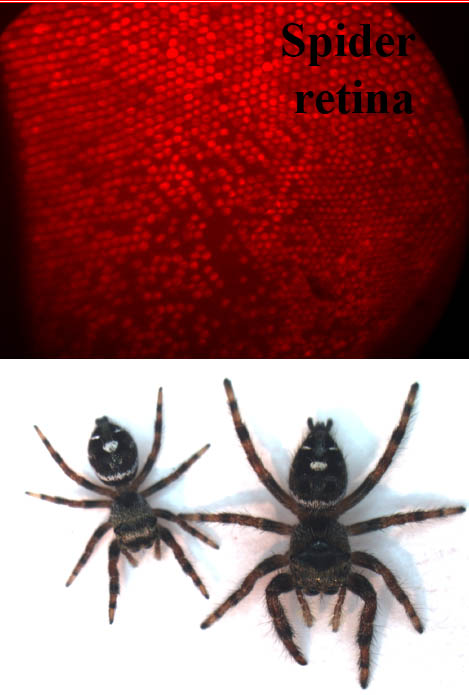
Sometimes interesting questions come up that do not directly relate to the mainstream projects of the lab. This adds tremendously to the excitement of science, and we often pursue such opportunities and collaborative efforts. Here are a few such projects currently ongoing in our lab.

Using our micro-ophthalmoscope to image spiders we noticed that some of them have substantial photo degeneration in their eyes (see image to right). Interestingly the degeneration seems to specifically occur in the densest region of the eye, which functionally is equivalent to our macular. We like to think of this as a spider version of macular degeneration. Furthermore, our impression is that this occurs most often in spiders that have been sub-optimally fed. We hence started a study where we raise spiderlings under different nutritional conditions, and then use our ophthalmoscope to evaluate photoreceptor degeneration. The image on the right shows two equally old spiderlings, one of which was starved. Since the procedure is non-intrusive, the same individual can be imaged repeatedly during their development. This project is primarily carried out by undergraduate student Miranda Brafford.
Another project in which we are involved is the development of better electrodes for physiology recording and stimulation. Our collaborators Dr. Noe Alvarez from Chemistry, and Dr. Vesco Shanov from Chemical and Materials Engineering (both at the University of Cincinnati) have developed a carbon nanotube microfiber that is non-toxic, soft and flexible and conductive. This material therefore could make a particularly good interface between the nervous tissue and stimulating or recording electronics. To determine if this indeed is the case we are fabricating electrodes and we are testing them on insects.
One of our test subjects are Madagascar hissing cockroaches that are large and long lived. Their size allows us to equip them with a receiver that has been developed by Backyard Brains and allows us to selectively stimulate the right or left antenna of the roach using electrodes made of the new material. The roach tends to turn away from whatever antenna is stimulated. Watch the video to see how this way we can remote control cockroaches this way. The led lights on the receiver indicate which antenna is being stimulated.
